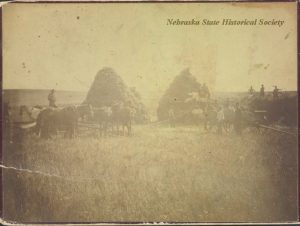
Upon arriving in Otoe County, Nebraska, Herman was apparently able to buy land outright, probably from the sale of his farm back in Minnesota. According to family lore, he took in Sebastian’s children after Sebastian’s death,
Herman’s oldest daughter Elizabeth told her children the following story about living on the farm:
One day Elizabeth’s family was visited in their farm home by an American Indian, dressed in a red shawl, who proceeded to enter the kitchen and take potatoes and bread from the table. The youngest child, Anna, crawled under the stove in fright.
Elizabeth recalled that during the early years on the farm, the family was very poor.
By the way, I came across another story in the Kreifels book, this one told by Melchior’s family about the trip from Minnesota to Nebraska:
It has been said, Melchior was going on two years of age and had learned to walk when the family moved. However, after the long trip in a covered wagon across the prairies from Minnesota to Nebraska, he had forgotten how to walk and had to learn this skill once again. Melchior’s older sister, Mary, told of gathering buffalo chips for fire to cook food on their trip to Nebraska and 50 years later she was still using a cast iron dutch oven the family had cooked with on their long journey from Minnesota.
Herman Kreifels and his family are listed in the 1880 Census records for Rock Creek Precinct in Otoe County, Nebraska.
His oldest two daughters, Elizabeth and Mary, were both married by the time of the 1880 Census and were living elsewhere with their husbands. The other eight children were still at home. Also in the home were Sebastian’s youngest three children: Herman, Henry and Anna. I am thinking that there must be guardianship papers somewhere in an archive – yet another thing on my “to-do” list when I’m in Nebraska next time.

One of the great things about the 1880 census is that there is sometimes an Agricultural Schedule available, and luckily there is an entry for this family! Here we get to see what their farm operation included. As is typical for pioneer families of this era, they had a very diversified farm and were probably quite self-sufficient. Here is what is included on the inventory:
- Herman owns his own land. He has 160 acres of which 125 are tilled, 22 are pasture, 1 is woodland, and the rest (12 acres) has improvements.
- His land is worth $3,500, his livestock is worth $1,256 and his farm equipment and machinery is worth $508.
- His farm produced $1,397 in products in 1879.
- He owned 6 horses, 6 mules, 5 milk cows, 10 other cows, 33 head of swine and 212 chickens. They had four calves born during 1879, and the milk cows produced 400 pounds of butter.
- The crops included 30 acres of barley, 35 acres of corn, 7 acres of oats, 6 acres of rye and 25 acres of wheat.
- He also had 1/2 acre of potatoes, 2 acres of orchard (apple and peach trees) and a small vineyard.
